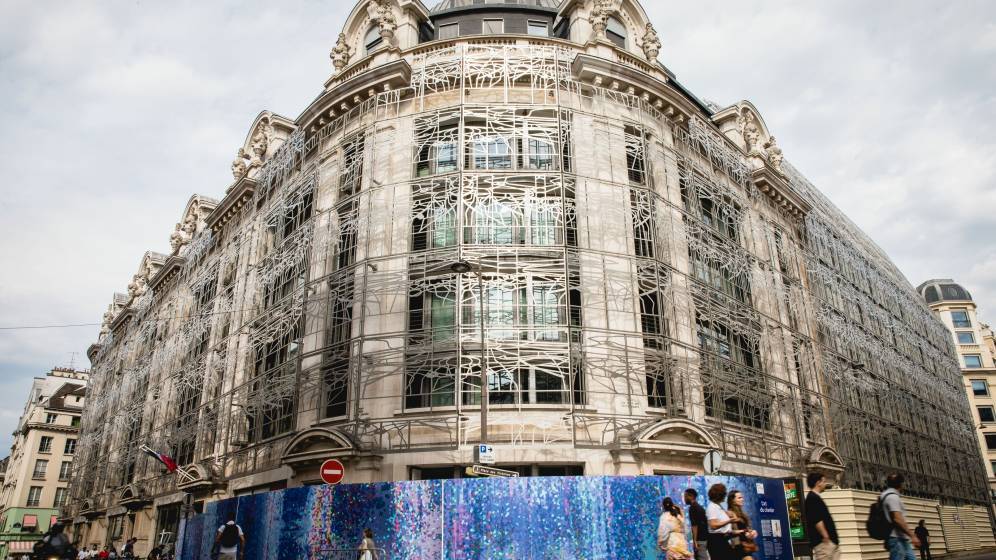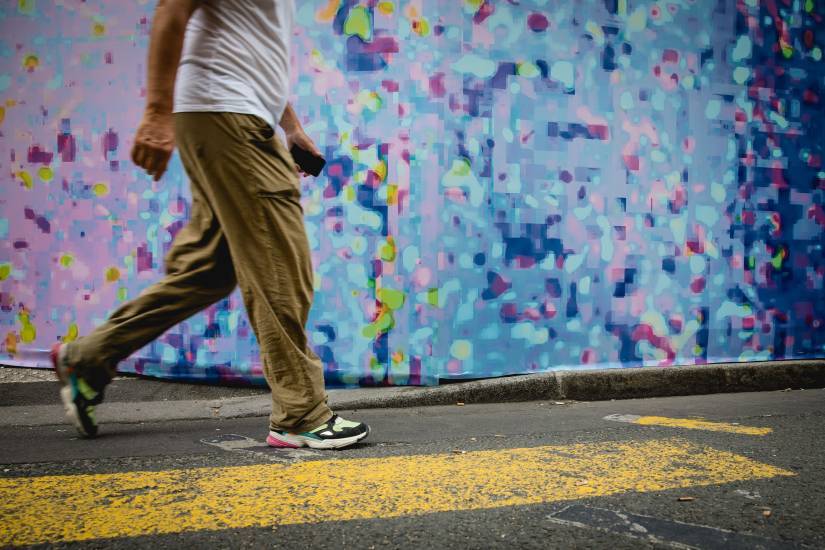In a few months, the reception of the Ministry of Culture will be moved to the corner of Saint-Honoré and Croix des Petits-Champs streets to find the original, more natural entrance to the building. This project is part of Phase 2 of the work to modernize the administrative space and consolidate departmental services at three sites instead of seven currently.
Since the beginning of this work, entrusted to the agency R-Architecture, the department involves young artists in all stages of redevelopment. A first part was launched in 2021 with two temporary projects: on the one hand an artistic commission to the artist Flora Moscovici ; on the other, a carte blanche given to five artists, students and young graduates of the École des Beaux-Arts de Paris.
Pointillist and digital techniques
The second phase began this summer with the progressive installation, in July, of a palisade around the site of the future new home of the ministry. This part is dressed, during the whole duration of the work until January 2024, of a work by Alexey Chernikov, student in fourth year at the Fine Arts of Paris. The young artist imagined «La compression du Renouveau», a large and long installation of thirty meters long and two high for which he mixes classical painting techniques of superpositions of color points, such as pointillism and divisionism, to digital image processing. « I like to work on everything related to artificial intelligence and algorithms. The current transition is similar to the one at the beginning of XXe century with the arrival of photography in front of painting. My goal is to try to understand what we can do with this technology that is developing so quickly and what it can bring us. »
As inspiration for this project, Alexey Chernikov quotes for example Claude Monet and his Water lilies, an impressionist work that took time to find its audience after the First World War in the face of the revival of art and movements such as Fauvism or Surrealism. « It is a little the same path as photography which took several decades to be recognized, notes the student. Just like today, it is believed that artificial intelligence and the projects created with it are not art. »
Digital paint palette
To build the work, Alexey started from the concept of generative loss : Over time and with the many shares on different media, a photo gradually loses its quality, resulting in its progressive pixelation. “ There, I take the lost information, I rework it and I put it forward '' he explains. He went in front of the ministry building, camera and tripod in hand, in the early morning to avoid the crowd and get photos in a bluish hue typical of this time of day. He took about fifteen shots of the facade, which he then glued together to make only one long frieze of photos in very high definition.
Then begins the export work, 365 in all like the number of days in a year, on photos of different quality to speed up the degradation process. Each export alters the basic image that will gradually lose in quality and reveal artifacts - visual defects - green and red. Alexey Chernikov then took his digital palette by working these color zones to bring out the openings of the building and attract the gaze of passers-by. The result has a double reading: one close, blurred and abstract with pixels, the other from afar, which concretely draws the silhouette of the building.
The work also continues inside the building, in the current lobby, as to accompany the visitor. This part follows the same digital processing process as outside and represents the future entry. “ This part will be installed as if there was no wall at the back: if we look straight, it is as if we looked at the entrance '' said Alexey Chernikov.
Accelerated training
With this new ephemeral work, the Ministry of Culture and the School of Fine Arts of Paris continue their partnership by involving young artists in major phases of work in the department’s buildings. “ This type of collaboration has become a real challenge for the school and its young talents, an unparalleled opportunity for professionalization », says Fabienne Grolière, Head of Fine Arts Sponsorship and Partnerships. Structuring a portfolio, presenting their career and project carefully, defending it in front of an audience, drawing up and maintaining a budget, coordinating service providers, negotiating a contract… All these notions, already addressed in the context of their training, in particular within a new degree course Fresque & Art en situation, are here put into practice. « This type of commands and exercises "real size" leads them to intervene in a temporal, legal, historical, public imposed framework. They thus learn to confront different issues and interlocutors, which is extremely formative for them and allows them to enrich their future career. In particular, it gives them more confidence in their practice and opens up new creative perspectives. »
Like Alexey Chernikov, about fifty students receive financial support every year for their work in the framework of calls for projects for public or private organizations, partners or patrons of the School, as well as prizes, scholarships, production aid. Enough to build a network for their early career.
See the work of Alexey Chernikov
A «Cosmic Garden» within the ministry
During the work, a second original and ephemeral work is installed in the interior garden of the ministry, on a wooden palisade that will mask a construction site area installed in the lower part of the garden. It will be visible to ministry officials until July 2024. Mathias Bensimon, just graduated from the Beaux-Arts of Paris, was interested in science and more particularly in quantum physics with his «Cosmic Garden» and was inspired by images of micro biology to create patterns on a 21 meter long fresco on the living.
Partager la page



